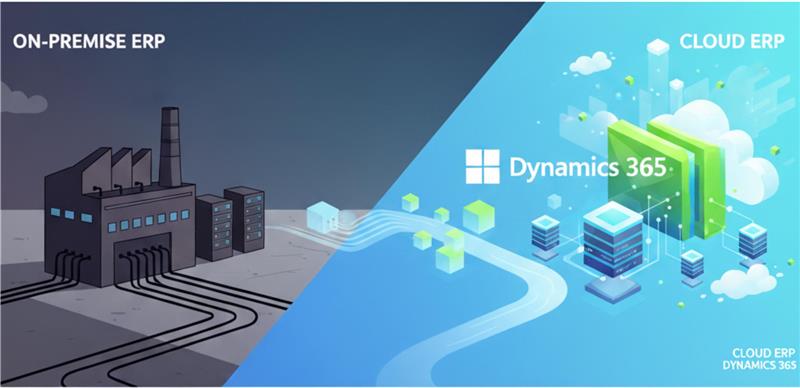In 2025, there is no debate about whether a company should opt for on-premise ERP or the cloud. Between cloud ERP and On-premise, cloud is the obvious choice.
However, the real question remains: how fast will the company transition? For many organisations, including the Australian company, the shift is driven through agility, cost optimisation, and security.
This is where the concept of composable ERP architecture plays a crucial role. It enables businesses to create flexible, modular systems that adapt to evolving needs — a capability only modern cloud ERPs, such as Dynamics 365, can deliver.
What do you need to understand it, and how does Dynamics 365 rank as one of the most beneficial choices?
Let’s find out.
Understanding the Debate: Cloud ERP vs On-Premise

Control, scalability, and innovation are the three main considerations when deciding between cloud ERP and on-premise ERP.
- On-Premise ERP: In-house server ownership and management give businesses the most control but come with a higher initial cost, more IT resources, and slower innovation cycles.
- Cloud ERP: controlled by the vendor, providing integrated AI features, quicker updates, and subscription-based pricing.
What Dynamics 365 Offers in 2025 (What Changes the Calculus)
There has been a lot that has changed in the cloud over the last few years, and this is where the ERP Dynamics 365 gets even more interesting:
- AI-Powered Automation and Insights: With Microsoft's 2025 release waves, finance, supply chain , and service teams will find it much simpler to automate tasks and generate insights thanks to advanced AI (role-based Copilot) and tighter Power Platform integration into Dynamics 365. This is a major factor in why companies are now considering Dynamics 365 ERP cloud.
- Flexible Deployment for Every Business Model: Australian teams can benefit from regulatory flexibility without sacrificing cloud innovation, thanks to the Dynamics 365 ERP cloud's support for multiple deployment paths (cloud, hybrid, and on-premises when necessary).
- Low-code/no-code Dynamics 365: Non-developers can create forms, logic, and automations using Dynamics 365 workflows (Power Apps + Power Automate), which lowers the barrier to D365 implementation and shortens the time to value.
Benefits of Cloud ERP over On-Premise
So, how does the company benefit from teh cloud ERP more?
- Faster Implementation: Reduced D365 Implementation cycles and ongoing updates result in a quicker time to value.
- Lower Capital Costs: switch to operational subscriptions from expensive upfront hardware and maintenance.
- Integrated Security and Compliance: Azure and Dynamics 365 provide regional certifications and enterprise controls essential for ERP security.
- No Extra Budget: Manage seasonal spikes without purchasing additional servers by scaling on demand.
- Constant Innovation: automated feature delivery (connectors, analytics, and artificial intelligence).
When On-Premise Still Makes Sense
- Highly customised legacy systems that must adhere to stringent air-gapped or data-residency regulations.
- Industrial control systems require isolation, and latency is essential.
Even in this case, a hybrid architecture or phased migration is feasible and less risky thanks to Dynamics 365 ERP deployment options.
The Role Of Your ERP Consultant During A Migration
A skilled ERP consultant transforms strategic objectives into workable plans for D365 implementation:
- Connect Dynamics 365 modules to business processes.
- Depending on risk and legal requirements, decide between on-premises, cloud, or hybrid deployment.
- Set up AI in Dynamics 365 ERP automation to produce results that are auditable and predictable.
- Prior to going live, test ERP security controls and create a security-first design.
Emerging Technical Advantages (What You’ll Actually Get)
- AI in Dynamics 365 ERP Automation: Copilot and embedded models eliminate tedious tasks and speed up decision-making in everything from intelligent demand forecasting to invoice OCR.
- ERP Blockchain Integration Benefits: For complex supply chains, adding specific blockchain layers can enhance provenance and supplier trust, serving as an overlay for traceability rather than a complete ERP replacement.
- No-code / low-code Dynamics 365: Allows business users to iterate and prototype while IT maintains platform integrity.
How To Choose: Checklist For Australian Decision-Makers
- 1. Clearly define your goals (growth, efficiency, and compliance).
- 2. Request a phased D365 implementation plan from your ERP consultant.
- 3. Analyse Dynamics 365 implementation services that include AI enablement, Power Platform, and security baseline.
- 4. Assess the business impact of piloting crucial processes on the Dynamics 365 ERP cloud.
- 5. Only when immutable provenance significantly reduces risk or expense should ERP blockchain integration benefits be considered.
Quick Comparison Table (Cloud ERP vs On-Premise)
Criteria | Cloud ERP | On-Premise ERP |
Innovation speed | Continuous updates & improvements | Slow, manual upgrades |
Capital cost | Opex (subscription-based) | Capex (large upfront investment) |
Compliance & data control | Regionally managed with vendor support | Direct physical control by the organisation |
Customisation | Configurable & extendable | Deeply customisable |
Implementation Tips: Make Your Dynamics 365 ERP 2025 Comparison Work For You
Consider cost, flexibility, security, and AI readiness when evaluating Dynamics 365 ERP 2025 options. Pay attention to the advantages of cloud ERP over on-premise that are important to your company, such as fewer administrative tasks, integrated disaster recovery, and predictable updates.
When choosing between on-premises and cloud ERP, employ a phased proof-of-concept and hire an ERP consultant or Dynamics 365 implementation services to verify assumptions and prevent scope creep. Start with measurable success.
Conclusion
The shift from on-premises to cloud ERP is no longer a matter of if, but when. With Microsoft Dynamics 365 offering low-code/no-code capabilities, modular flexibility, and support for two-tier ERP models, businesses gain scalability without sacrificing control.
Whether your goal is faster deployment, improved security, or continuous innovation, Dynamics 365 offers a composable framework to achieve all of these objectives.
Partnering with DHRP, a trusted expert in Dynamics 365 implementation and consulting, ensures your ERP migration is seamless, strategic, and tailored to your business goals. The future of ERP is connected, intelligent, and cloud-driven — and it starts today.



































































































